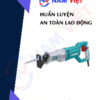Occupational Safety Training for Operating Table Saws
99,000 ₫
Note: The price above is calculated per person and may fluctuate depending on the number of participants in the course and market conditions. For more accurate pricing support, please refer to the price list or contact our consulting staff directly.
Occupational safety is an important issue when operating a table saw and must be addressed promptly to ensure the health and safety of workers and enhance the reputation of businesses here. The Occupational Safety Training course is one of the effective solutions to raise awareness of how to prevent workplace accidents for workers operating a table saw.
Table of Contents
Toggle1. Overview of Table Saws
a. What is a table saw?
A table saw machine is a type of power tool used to cut and process sheet materials such as wood, MDF boards, plywood, and other materials. It consists of a flat worktable with a rotating saw blade in the center, which can be adjusted for height and cutting angle. The user places the material to be cut on the table and then pushes it through the saw blade to perform the desired cuts.
Table saws can be used to perform various types of cuts, including crosscuts, rip cuts, and angle cuts. This makes the table saw an essential tool in construction, woodworking, and many other applications involving wood processing and fabrication. However, due to its power and potential risk of injury if not used properly, operating a table saw requires caution and safety knowledge.

b. How a table saw works
The operating principle of a table saw is quite simple. It works as follows:
- Worktable: The table saw has a flat worktable, usually rectangular or square, where you place the material to be cut.
- Saw blade: At the center of the worktable is a rotating blade, typically a circular or dado blade, mounted on an arbor. The blade height and angle can be adjusted.
- Motor: The table saw is equipped with a powerful motor to spin the blade, generating cutting power and blade movement.
- User: The operator places the material on the worktable and pushes it through the blade to cut. Cutting must be performed carefully and safely to avoid injury.
When the table saw operates, the rotating blade spins rapidly to cut through the material placed on the worktable. The blade height and angle can be adjusted to create different cuts, including crosscuts, rip cuts, and miter cuts. Users must always follow safety rules and use protective gear such as safety goggles and safety belts to ensure safe operation.

c. Industries that use table saws
Table saws are used in various manufacturing and industrial sectors, including:
- Wood processing industry: An essential tool for cutting, splitting, and processing wood into various sizes and shapes for making furniture, decorations, industrial wood products, and more.
- Construction: Used to cut and process building materials such as wood, plywood, panels, and insulation boards for doors, windows, and other building components.
- Furniture manufacturing: Used to cut and process wood parts during the production of furniture such as tables, chairs, cabinets, beds, and other items.
- Industrial wood production: Factories and workshops use table saws to produce wood boards, planks, and other components for flooring, partitions, and other industrial wood products.
- Packaging materials production: Can also be used to cut and process packaging materials such as paper and cardboard in packaging and box manufacturing.
2. Overview of Safety Training for Operating Table Saws
a. What is occupational safety training?
- Occupational safety training for operating table saws provides awareness on how to prevent workplace accidents. Workers who work directly with table saws fall into group 3.
- The safety training course helps workers identify and avoid hazards, reducing the risk of accidents during work.
REGISTER FOR OCCUPATIONAL SAFETY TRAINING
b. Training duration
Initial safety training:
- Total training duration is at least 24 hours, including testing time.
- 8 hours of theory on occupational safety and hygiene laws and policies
- 8 hours of basic occupational safety and hygiene knowledge
- 4 hours of theory on specialized safety training
- 2 hours of practical specialized safety training
- 2 hours of final theoretical examination
The safety training center will arrange multiple training sessions depending on company schedules. Typically, there will be 6 sessions over 3 days, provided the company can arrange continuous learning time.
Periodic safety training:
- Before the occupational safety card expires, workers must undergo periodic training, with the periodic training time being at least 50% of the initial training time.
Explanation: The total periodic training duration is at least 12 hours, including testing. After completing periodic training and passing the test, workers will have their safety card renewed.
c. Training content
| No. | TRAINING CONTENT | TRAINING DURATION (HOURS) | |||
| Total | Of which | ||||
| Theory | Practice | Test | |||
| I | Occupational safety and hygiene laws and policies | 8 | 8 | 0 | 0 |
| 1 | Overview of legal documents on occupational safety and hygiene. | 6 | 6 | ||
| 2 | System of occupational safety and hygiene standards and regulations. | 1 | 1 | ||
| 3 | Specific regulations by government authorities on occupational safety and hygiene when constructing, expanding, or renovating facilities that produce, use, store, and inspect machines, equipment, materials, and substances requiring strict safety measures. | 1 | 1 | ||
| II | Basic occupational safety and hygiene knowledge | 8 | 8 | 0 | 0 |
| 1 | Basic knowledge of workplace hazards and harmful factors. | 4 | 4 | ||
| 2 | Methods to improve working conditions. | 1 | 1 | ||
| 3 | Safety culture in production and business. | 1 | 1 | ||
| 4 | Rights and obligations of employers and employees; policies and regimes on occupational safety and hygiene; functions and duties of the occupational safety network. | 1 | 1 | ||
| 5 | Occupational safety rules, signage, and use of safety devices, personal protective equipment; first aid skills and prevention of occupational diseases. | 1 | 1 | ||
| III | Specialized training content | 6 | 4 | 2 | 0 |
| Comprehensive knowledge of machines, equipment, and hazardous substances; risk assessment and management; safe work procedures for machines, equipment, and substances requiring strict safety measures. | 6 | 4 | 2 | ||
| IV | Final test | 2 | 2 | 0 | 0 |
| Total | 24 | 22 | 2 | ||
See more training content for 6 groups
d. Occupational Safety Card
After completing the safety training course and passing the exam, the worker will be issued an occupational safety card (commonly referred to as a group 3 safety certificate).
The group 3 safety card will display the worker’s name, date of birth, job title, and specific working environment, as well as training duration, official stamp, and signature verifying course completion.
According to Article 24, Clause 2 of Decree 44/2016/NĐ-CP, there are two cases:
- If the employer and employee have a labor contract, the employer must sign, stamp, and seal the safety card for the group 3 worker after training and passing the exam.
- If the worker is freelance, seasonal, or does not have a labor contract, the training provider must sign, stamp, and seal the safety card after the worker completes training and passes the exam.

3. Hazards When Operating a Table Saw
Operating a table saw can involve many hazards, and failing to follow safety rules may lead to serious injuries or accidents. Below are some of the common hazards when using a table saw:
- Injuries from the saw blade: The blade spins at high speed and can cause severe injuries if safety rules are not followed or if protective accessories such as safety glasses and a safety belt are not used.
- Powering off: The table saw must be switched off and unplugged before changing the blade or performing any maintenance. Otherwise, serious accidents can occur if the machine unexpectedly starts.
- Rip fence: Use a rip fence to keep the workpiece a safe distance from the blade and ensure straight cuts. Without a rip fence, the material may move unpredictably and cause accidents.
- Push stick: A push stick is an important safety device to keep hands away from the blade while feeding material through. Use a push stick correctly to avoid injury.
- Blade guards: A table saw should have guards around the blade to prevent contact and reduce the risk of injury.
- Electrical safety: Ensure the power supply and related electrical equipment are functioning properly and that there are no frayed wires or electrical leaks.
- Working alone: Do not work alone when using a table saw. Always have someone nearby to assist if needed.
- Safety training and knowledge: Before using a table saw, ensure the operator has been trained and understands the safety rules.
- Machine inspection: Inspect the table saw before each use to ensure it operates normally and safely.
- Use personal protective equipment: Always use protective gear such as safety glasses, hearing protection (earmuffs), and a safety belt.

4. Measures to Control Workplace Accidents When Operating a Table Saw
To control and minimize the risk of workplace accidents when operating a table saw, below are important measures users should follow:
- Training and instruction: Ensure all table saw operators have been trained in safe operation. This includes understanding safety rules, operating procedures, and correct use of protective accessories.
- Use protective equipment: Always use protective gear such as safety glasses, hearing protection (earmuffs), safety belts, and a push stick. These items help protect users from injury when working near the blade.
- Inspect the saw: Before each use, check the table saw to ensure it is operating properly. Make sure the blade is not worn or damaged and that all blade guards function correctly.
- Use the rip fence: Use a rip fence to keep the workpiece a safe distance from the blade and ensure straight cuts. This helps prevent unexpected movement of the material and reduces the risk of injury.
- Do not work alone: Avoid working alone when using a table saw. Always have someone nearby to assist or provide first aid if an incident occurs.
- Electrical safety: Ensure the power supply and related electrical equipment are functioning properly and that there are no frayed wires or electrical leaks.
- Perform regular maintenance: Maintain the table saw regularly to ensure it always operates reliably and safely.
- Work slowly and carefully: Do not rush or misuse the table saw. Work slowly and carefully, following safety rules for every cut.
- Turn off the machine when not in use: Always switch off the table saw when not in use and ensure the blade has come to a complete stop before any maintenance or adjustments.
- Supervise the process: Monitor the workflow and ensure all participants comply with safety rules.
- Schedule periodic inspections of the table saw to detect safety issues early—such as wear, damage, or mechanical faults—thereby reducing the risk of workplace accidents.
5. Benefits of Occupational Safety Training
An Toàn Nam Việt provides your business with outstanding benefits upon completion of safety training courses in accordance with Decree 44/2016/NĐ–CP on occupational safety and hygiene for companies, factories, and enterprises.
- Workers can identify potential risks of workplace accidents and take preventive measures to avoid incidents.
- Businesses establish risk-prevention measures in production, operation, and maintenance processes.
- Minimize costs arising from occupational safety incidents.
- Uninterrupted production increases labor productivity and product quality.
- Ensure compliance with occupational safety laws and avoid legal risks.
- Build credibility and professionalism in all aspects, thereby elevating your brand.
An Toàn Nam Việt’s training programs help individuals defend against external risk factors so they can avoid dangers that may lead to injury—or, more seriously, fatality.
REGISTER FOR OCCUPATIONAL SAFETY TRAINING
6. Customer Feedback After Completing the Training
An Toàn Nam Việt has many years of experience partnering with businesses across Vietnam—especially in the southern provinces. This responsibility is invaluable to us, which is why our Occupational Safety Training is becoming increasingly professional. Our motivation to grow comes from both positive feedback and constructive suggestions from our clients. Below are comments from partners we’ve served.
Bac Nam E&C Construction Investment Joint Stock Company
“This was my first time using An Toàn Nam Việt’s services and I was impressed by the 24/7 support from the consulting team. Classes were organized quickly and conveniently for our company. Many thanks to Nam Việt for the excellent service!”
Hoa Dat Construction & Trading Joint Stock Company
“Nam Việt’s services have greatly helped us streamline occupational safety and complete safety documentation for our operations. The consulting team is enthusiastic and responsive to our questions. Five stars for Nam Việt.”
See more customer interviews after using our services from An Toàn Nam Việt.
7. An Toàn Nam Việt’s Competency in Occupational Safety Training
An Toàn Nam Việt is a reputable, high-quality occupational safety training center in Vietnam today. We conduct ongoing training sessions at manufacturing plants, factories, and construction sites nationwide (63 provinces and cities across Vietnam).
REGISTER FOR OCCUPATIONAL SAFETY TRAINING
Safety training license
- An Toàn Nam Việt has been inspected and certified by the Department of Occupational Safety under the Ministry of Labour – Invalids and Social Affairs (MOLISA) as meeting the conditions to conduct occupational safety and hygiene training. This further strengthens our capability in occupational safety training.

Training materials and lessons
- Before safety training materials are used in occupational safety courses, they are reviewed and approved to ensure accuracy and effective application.
- Our instructors’ teaching methods are standardized according to An Toàn Nam Việt’s training standards—approaches developed and refined by experts in occupational safety and hygiene training to maximize learner comprehension.
Facilities
- Controlling classroom factors that affect training improves teaching efficiency and learner outcomes.
- Our training facilities provide spacious classrooms that meet standards for area, lighting, and training equipment, etc.
8. A Reputable, High-Quality Safety Training Center Nationwide
At An Toàn Nam Việt, we always put our dedication to occupational safety training first. For us, imparting self-protection knowledge to workers so they can stay safe while earning a living contributes to nation building.
To ensure effective training, we prepare carefully and meticulously, down to the smallest details—from tools, equipment, and teaching devices to curricula, materials, sound, and lighting.
Our occupational safety trainers are experts with many years of experience. Some have conducted research on hazard identification across industries and how to prevent them.
Lessons are distilled from real-world practice and delivered vividly and accessibly to workers. These elements help learners feel comfortable during class and absorb the material well. Naturally, our content strictly follows Decree 44/2016/NĐ-CP.
From there, learners master many hazard-prevention measures and self-protection methods, and apply them appropriately in their actual work.
Our training center is proud to provide reputable, professional occupational safety training services with the following advantages:
- Competitive training fees while maintaining quality.
- Flexible training schedules tailored to your company’s production.
- Fast, legally compliant procedures for issuing training certificates.
- Experienced trainers with many years in the field.
- Classrooms managed to optimize factors that enhance teaching efficiency and learning outcomes.
- Curricula tailored to the occupational safety needs of enterprises.
- Dedicated, professional support to provide accurate and prompt assistance.

9. Additional Occupational Safety Training Resources
- Occupational Safety Training Materials
- Safety Guide for Operating a Table Saw (Table Saw Machine)
- Occupational Safety Test Bank
- Multiple-Choice Safety Test: Operating a Table Saw
- Training Slides: Occupational Safety for Operating a Table Saw
1 review for Occupational Safety Training for Operating Table Saws
No comments yet















phanminhhang341
Đơn vị chuyên nghiệp về huấn luyện an toàn lao động